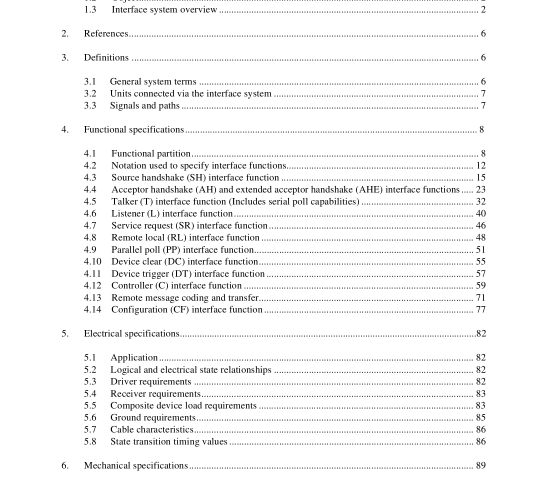IEEE N42.31-2003 pdf download.IEEE Standard for Higher Performance Protocol for the Standard Digital Interface for Programmable Instrumentation
This standard applies to interface systems used to interconnect both programmable and nonprogrammable electronic measuring apparatus with other apparatus and accessories necessary to assemble instrumentation systems. It applies to the interface of instrumentation systems, or portions of them, in which the
a) Data exchanged among the interconnected apparatus is digital (as distinct from analog)
b) Number of devices that may be interconnected by one contiguous bus does not exceed 15
c) Total transmission path lengths over the interconnecting cables does not exceed 20 m
d) Data rate among devices does not exceed 8 000 000 B/s
The basic functional specifications of this standard may be used in digital interface applications that require longer distances, more devices, increased noise immunity, or combinations of these. Different electrical and mechanical specifications may be required (for example, symmetrical circuit configurations, high threshold logic, special connectors, or cable configurations) for these extended applications.
This standard may also be applicable to other instrumentation system elements, such as processors, stimulus, display, or storage devices, and terminal units found useful in instrumentation systems. It applies generally to laboratory and production test environments that are both electrically quiet and restricted as to physical dimensions (distances between the system components).
This standard deals only with the interface characteristics of instrumentation systems to the exclusion of design specifications’ consideration of radio-interface regulations, performance requirements, and safety requirements of apparatus.
NOTE—For the latter two items, reference is made to IEC Publication 348 (1978) Safety Requirements for Electronic Measuring Apparatus and IEC Publication 359 (1971) Expression of the Functional Performance of Electronic Measuring Equipment.
Throughout this standard, and insofar as further distinction is not necessary, the term “system” denotes the bit-parallel byte-serial interface system that, in general, includes all circuits, cables, connections, message repertoire, and control protocol to effect unambiguous data transfer between devices; and the term “device” or “apparatus” denotes any programmable measurement device or other product connected to the interface system that communicates information via, and conforms to, the interface system definition.
A primary focus of this standard is to set forth an interface system to interconnect self-contained apparatus to other apparatus by external means. This same standard may be applied to interconnecting the internal sub- sections within a self-contained equipment.
1.2 Object
This standard is intended
a) To define a general-purpose system for use in limited-distance applications
b) To specify the device-independent mechanical, electrical, and functional interface requirements that the apparatus shall meet in order to be interconnected and to communicate unambiguously via the system
c) To specify the terminology and definitions related to the system
d) To enable the interconnection of independently manufactured apparatus into a single functional system
e) To permit devices with a wide range of capability—from the simple to the complex—to be interconnected to the system simultaneously
f) To permit direct communication among the devices without requiring all messages to be routed to a control or intermediate unit
g) To define a system with a minimum of restrictions on the performance characteristics of the devices connected to the system
h) To define a system that permits asynchronous communication over a wide range of data rates
i) To define a system that, of itself, may be relatively low cost and permits the interconnection of lowcost devices
j) To define a system that is easy to use
1.3 Interface system overview
1.3.1 Interface system objective
The overall purpose of an interface system is to provide an effective communication link over which messages are carried in an unambiguous way among a group of interconnected devices.IEEE N42.31 pdf download.IEEE N42.31-2003 pdf download
IEEE N42.31-2003 pdf download

Leave a Reply